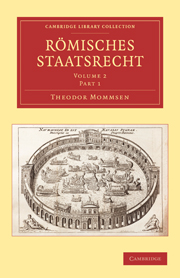Book contents
- Frontmatter
- Contents
- Das Königthum S. 3—15
- Die magistratische Befugniss des Oberpontifex S. 16—69
- Das Consulat S. 70—124
- Die Dictatur S. 125—153
- Das Reiterführeramt S. 156—164
- Der Consulartribunat S. 165—175
- Die Prätur S. 176—216
- Die Provinzialstatthalterschaft S. 217—246
- Der Volkstribunat S. 247—303
- Die Censur S. 304—442
- Die Aedilität S. 443—491
- Die Quästur S. 492—538
- Magistratische Offiziere S. 539—545
- Die magistratische Geschwornenleitung S. 546—555
- Der Vigintisex-, später Vigintivirat S. 556—571
- Ausserordentliche Beamte für die Reservatrechte der Gemeinde S. 572—600
- Ausserordentliche Aushülfsbeamte S. 601—637
- Die Senatsboten (legati) S. 638—661
- Die ausserordentlichen constituirenden Gewalten S. 662—697
Die Quästur S. 492—538
Published online by Cambridge University Press: 29 August 2010
- Frontmatter
- Contents
- Das Königthum S. 3—15
- Die magistratische Befugniss des Oberpontifex S. 16—69
- Das Consulat S. 70—124
- Die Dictatur S. 125—153
- Das Reiterführeramt S. 156—164
- Der Consulartribunat S. 165—175
- Die Prätur S. 176—216
- Die Provinzialstatthalterschaft S. 217—246
- Der Volkstribunat S. 247—303
- Die Censur S. 304—442
- Die Aedilität S. 443—491
- Die Quästur S. 492—538
- Magistratische Offiziere S. 539—545
- Die magistratische Geschwornenleitung S. 546—555
- Der Vigintisex-, später Vigintivirat S. 556—571
- Ausserordentliche Beamte für die Reservatrechte der Gemeinde S. 572—600
- Ausserordentliche Aushülfsbeamte S. 601—637
- Die Senatsboten (legati) S. 638—661
- Die ausserordentlichen constituirenden Gewalten S. 662—697
Summary
Um die schwierige Frage über die Entstehung der Quästur so weit möglich ins Klare zu bringen, ist vor allem festzustellen, was uns die Quellen dartlber berichten. Dabei tritt uns die auffallende, aber nicht wegzuleugnende Thatsache entgegen, dass in der älteren und besseren Ueberlieferung es über die Entstehung der Quästur gänzlich an Angaben gefehlt hat. Cicero erwähnt die Quästoren in Beziehung auf den Prozess des Sp. Cassius im J. 269), ohne ihrer Einsetzung zu gedenken. Livius nennt sie ebenfalls zuerst bei Gelegenheit desselben Prozesses); und dass dies nicht auf zufälligem Uebersehen beruht, geht daraus hervor, dass er weiterhin die Quästur zu den neueren Institutionen der Gemeinde zählt und ihre Einrichtung zwischen die der plebejischen Magistrate 264 und des Decemvirats 303 setzt) — was eben nur heissen kann, dass er die erste Erwähnung derselben unter dem J. 269 fand. In gleicher Weise führt Pomponius in seiner chronologischen Uebersicht der römischen Magistraturen die Quastur zwischen den plebejischen Magistraten und dem Decemvirat auf). Nicht einmal bei Dionysios findet sich hierüber ein Bericht; er nennt die Quästoren zuerst beilaufig bei Gelegenheit des Verkaufs der Beute im J. 247 und sodann mehrere Male bei ähnlichen unwichtigen Anlässen); in politisch eingreifender Thätigkeit erscheinen sie auch bei ihm zuerst bei dem Prozess des Cassius).
- Type
- Chapter
- Information
- Römisches Staatsrecht , pp. 492 - 538Publisher: Cambridge University PressPrint publication year: 2010



